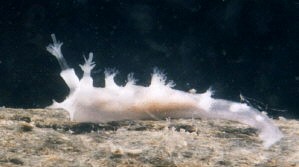
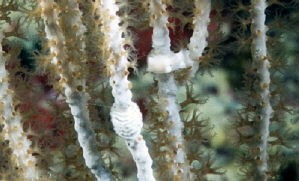
Tritonia nilsodhneri
Marcus, 1983
Order: NUDIBRANCHIA
Suborder: DENDRONOTINA
Family: Tritoniidae
DISTRIBUTION
Southern France, southern England, western Ireland, northern Spain.
PHOTO
Cala Joncols, nr Rosas, Costa Brava [Mediterranean coast of Spain], both divesite "La Piscina". UPPER: May 01, 2000, 12 m depth, size 16 mm. LOWER: On gorgonian prey Eunicella singularis. April 22, 2000, 8 m depth, size of the slug 13 mm. PHOTOS: Erwin Koehler.
Thompson & Brown (1984) report that in Britain this species feeds on the gorgonian Eunicella verrucosa which ranges in colour from white to pink. Individuals of Tritonia nilsodhneri match the colour of their food. See messages below for reports of other gorgonian prey inn other parts of its range.
Reference:
• Thompson, T.E. & Brown, G.H. (1984) Biology of Opisthobranch Molluscs, Vol 2. Ray Society: London.
Rudman, W.B., 2000 (May 30) Tritonia nilsodhneri Marcus, 1983. [In] Sea Slug Forum. Australian Museum, Sydney. Available from http://www.seaslugforum.net/find/tritnils
Related messages
Tritonia nilsodhneri feeding and laying eggs
April 14, 2010
From: Dominique Horst
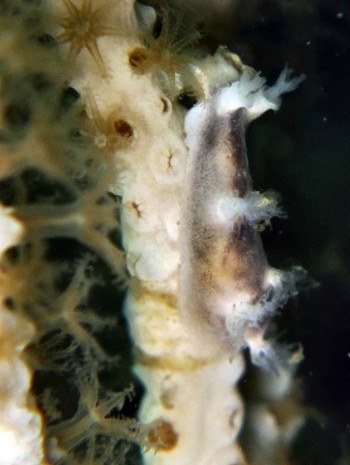
Hi Bill,
I am pretty sure this is Tritonia nilsodhneri.
The upper photo shows it feeding on the gorgonian Eunicella stricta.
The second animal may be laying or covering its eggs...
Locality: Banyuls, 9 m, France, Mediterranean sea, 26 March 2010. Length: 7 mm. Photographer: Dominique Horst.
Kind regards,
Dominique
dominique.horst@wanadoo.fr
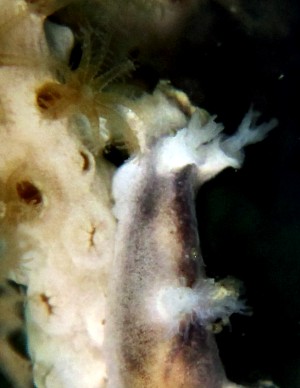
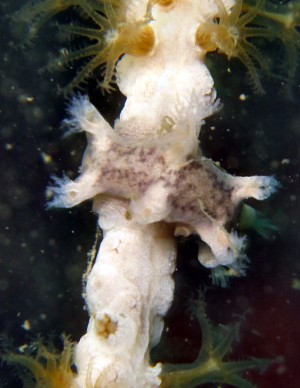
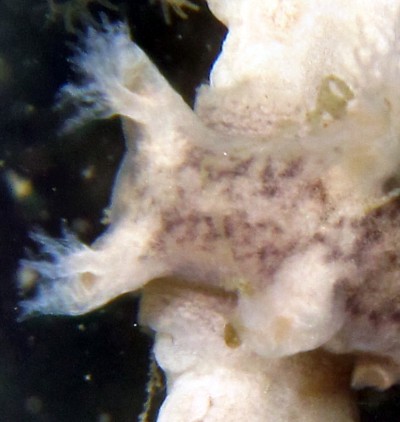
Thanks Dom,
The second photo definitely shows the animal on topmof the egg ribbon which has been laid around the 'trunk' of the gorgonian colony. Since nudibranchs don't 'sit' on their eggs like birds, I would suspect it is in the process of depositing the egg string.
Best wishes,
Bill Rudman
Re: Food and colour in Tritonia nilsodhneri
October 6, 2009
From: Ricardo Roberto Fernández
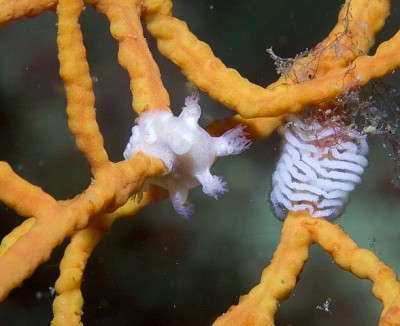
Concerning message #4312:
Dear Bill,
The matter about the coloration and food of Tritonia nilsodhneri is still challenging. I enclose two photographs I've taken recently of this animal on Leptogorgia cf. sarmentosa. This species of gorgonian has two different colours in the Viveiro Stuary (Galicia - Spain). The one on the purple one is like Picton's shot, while the ones on the orange gorgonian is white. After so many years observing these animals, I cannot think the animals have just arrived on the orange gorgonian, after feeding on the white ones (Eunicella verrucosa ). Thus, it must be related to something else, may be do they like to use other gorgonians for reproduction? Why so? This really puzzles me! Thank you for your comments on the photographs I sent a lot of time ago [message #9841]. Yes, I quite agree with your suggestions.
best regards!
Ricardo R. Fdez
Locality: Viveiro Stuary, -10 m, Galicia - Spain, Atlantic Ocean, 02 May 2009, on gorgonians. Length: 7 mm. Photographer: Ricardo Roberto Fernández.
rirofermar@hotmail.com
Fernández Martínez, R. R., 2009 (Oct 6) Re: Food and colour in Tritonia nilsodhneri. [Message in] Sea Slug Forum. Australian Museum, Sydney. Available from http://www.seaslugforum.net/find/22568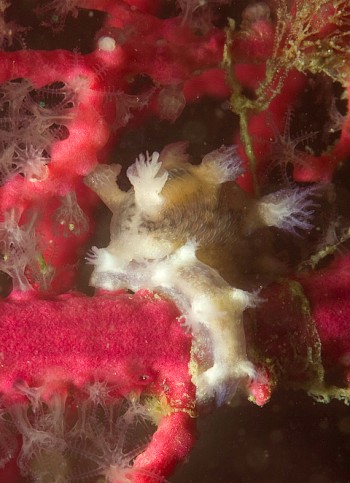
Thanks Ricardo,
One thing worth considering is whether this species just eats the gorgonian polyps. As the polyps are usually colourless or white then we wouldn't expect much colour difference if it was based on pigment exchange from food to feeder. However if this Tritonia also eats part of the colourful stalk (pink or yellow in this case) then we might expect the animals to be a better match with the gorgonian, as its colour is really dominated by the stalk colour.
So I guess one thing to examine is which part of the colony does T. nilsodhneri eat?
Best wishes,
Bill Rudman
Re: Tritoniid on gorgonian - Portugal
April 30, 2008
From: Alma Sánchez Santos
Concerning message #20799:
Dear Joao & Dr. Rudman,
This animal is Tritonia nilsodhneri.
Best wishes,
Alma Sánchez
almasanchez83@hotmail.com
Sánchez-Santos, A., 2008 (Apr 30) Re: Tritoniid on gorgonian - Portugal. [Message in] Sea Slug Forum. Australian Museum, Sydney. Available from http://www.seaslugforum.net/find/21543Thanks Alma,
Can you give us any help in identifying the gorgonian, and do you find Tritonia nilsodhneri on this gorgonian often?
Best wishes,
Bill Rudman
Tritoniid on gorgonian - Portugal
April 23, 2008
From: Joao Pedro Silva
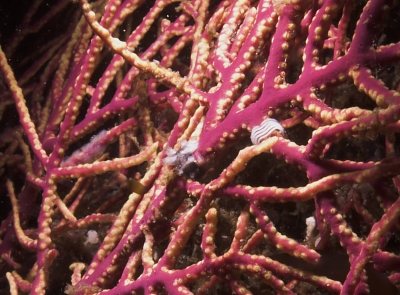
Dear Bill,
The Portuguese Center of Underwater Activities (www.cpas.pt), a founding member of CMAS, has a group studying portuguese gorgonians. They made me look more carefully to gorgonian predators and so I found this tritoniid. Is it Marionia blainvillea or Tritonia nilsodhneri?
Although the individual is curled I expect it to be smaller than 1 cm.
Locality: Sesimbra, 10m, Portugal, North Atlantic, 20 September 2007, Rocky bottom. Length: less than 1cm. Photographer: Joao Pedro Silva.
Cheers,
Joao Pedro
jpsilva@uwphotographer.net
Silva, J. P., 2008 (Apr 23) Tritoniid on gorgonian - Portugal. [Message in] Sea Slug Forum. Australian Museum, Sydney. Available from http://www.seaslugforum.net/find/20799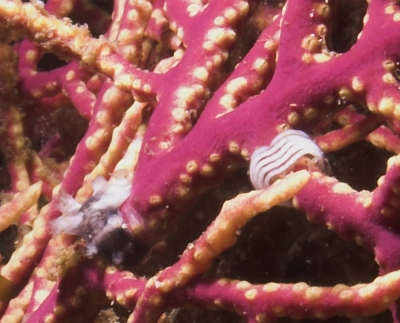
Dear Joao Pedro,
I am afraid I can't see enough of the animal to even guess at its identity but it is apparently a species which feeds on gorgonians. The only European tritoniids I know that feeds on gorgonians are the two you mention. The colour looks a bit unusual for both of them but from the bushy gills my guess is that it is a colour form of the Marionia - but hopefully a local expert will recognise it for us.
Best wishes,
Bill Rudman
Tritonia nilsodhneri from Guernsey
July 16, 2003
From: Richard Lord
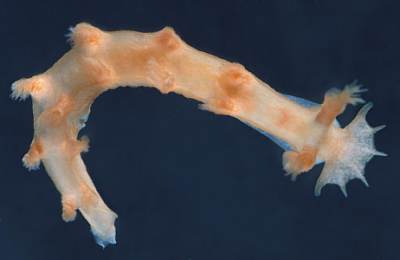
Dear Bill:
Here are some photos of Tritonia nilsodhneri from Guernsey. The egg ribbon is on its food, the soft coral Eunicella verrucosa.
As with my other photos this was collected by crab potter Clive Brown who works strings of crab pots along Guernsey's south coast (Channel Ids, English Channel, Great Britain (about 49 24 N and 002 38 W)).
Best Wishes,
Richard
fishinfo@guernsey.net
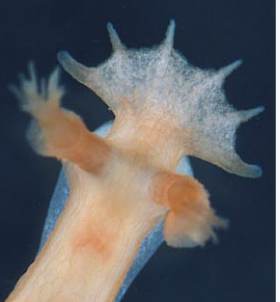
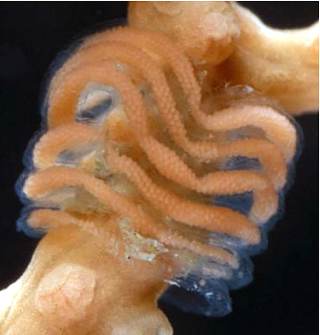
Thanks Richard,
Bill Rudman
Tritonia nilsodhneri colour
May 8, 2003
From: Ricardo Roberto Fernández
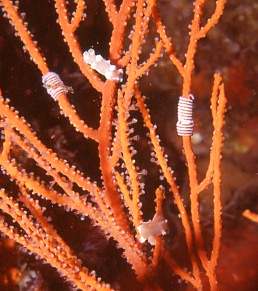
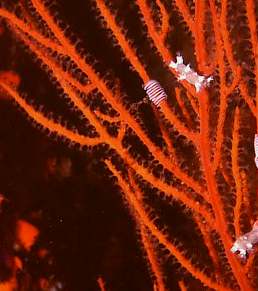
Dear Dr. Rudman,
I am reading all the information related to the species that I have recorded with my camera and I have found the discussion about the colour of Tritonia nilsodhneri quite interesting. Although it can match the colour of the gorgonian on which it lives, sometimes it lives on gorgonians of quite a different colour and keeps its white colour. The images I am enclosing were taken in Asturias, on the Northern coast of Spain (close to Galicia) and there are two individuals with their egg masses on what I think it is Lophogorgia ceratophyta (= Leptogorgia sarmentosa). As you can see, they don't match at all the colour of the gorgonian, so I wonder if they don't rely on colouur defences for surviving. Could it be that they get the colour of the gorgonian gradually, so when they arrive on a new one it takes them a while to get sufficient pigment from the new host? If so, wouldn't they be in danger for too long? This is why I think they might rely on some other defences. What do you think?
Best wishes and thank you very much for your wonderful site,
Ricardo Roberto Fernández.
rirober@telecable.es
Dear Ricardo,
You raise some interesting questions. Have you seen the section on colour in nudibranchs. Some of your questions are discussed there. Certainly some nudibranchs get their pigment from their food so are very well camouflaged, although in species such as the sponge-feeding Rostanga arbutus, they also have bristles all over he back so when they crawl off the sponge and are no longer hidden, they are disguised as a small bit of inedible sponge.
But to your tritoniids. I am not sure if anyone has studied whether the pigment in this species is from their food or a result of their own genetic makeup. Without some experimentation its not possible to say if the presence of one or two pink animals amongst a large population of grey animals on a grey gorgonian, means they are recent arrivals still trying to change colour, or just a couple of animals which are showing the 'pink' phase of the species genetic makeup. If it is genetic, then although it may make life a little dangerous for them, the pink ones are incredibly valuable for the species because they are the variation which gives the species the chance to survive in an area where only pink gorgonians exist.
About other defences. Gorgonians have a great store of nasty chemicals in their tissues, and often gorgonian feeders incorporate some of these chemicals in their own tissues to deter potential predators. Again I am not sure if Tritonia nilsohdneri has been examined for such chemicals but I suspect it probably has such
anti-feedant chemicals in its skin as a second line of defence.
Best wishes,
Bill Rudman
Tritonia nilsodhneri from Mediterranean
August 5, 2002
From: Marina Poddubetskaia
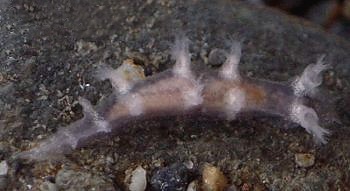
Dear Bill,
There are some photos of Tritonia nilsodhneri and its egg-ribbon from French Mediterranean.
UPPER: July 01, 2002, Cerbere, France. Site: Les 3 moines, Size: 12-13mm
LOWER: July 02, 2002, Cerbere, France. Site: Cap Negre. Depth: 19m
Size: animal = 7-8mm / egg-ribbon = 5mm
Photos: Marina Poddubetskaia - Nembro website
Best wishes,
Marina.
nembro@nembro.info
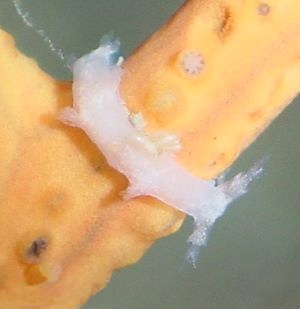
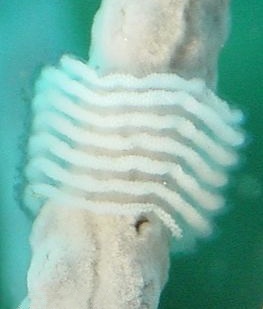
Thanks Marina,
Bill Rudman
Re: Food of Tritonia nilsodhneri
October 24, 2001
From: Helmut Zibrowius
Dear Bill,
At Bernard Picton's request I have had a look at the gorgonians in the Forum on which Tritonia nilsodhneri has been photographed and suggest the following identifications. I have sent a separate message concerning the gorgonians that Marionia blainvillea has been photographed on.
• The gorgonian in Erwin Koehler's photo from Cala Joncols is Eunicella singularis
(the expanded polyps show zooxanthellae pigmentation), bark is whitish.
• The gorgonian in Bernard Picton's photo from Galicia, Spain is, as suggested by Bernard, a species of Leptogorgia.
• I am not an expert on North Atlantic gorgonians but in spite of colour differences
I think all the photos in Bernard Picton's message from England and the Channel Ids could be Eunicella verrucosa.
• I agree with Baki Yokes' identification of the gorgonian in his photo from Saros Bay, Turkey as a whitish form of Eunicella singularis (but mostly contracted; when polyps are out, they look whitish - E. singularis also can occur without zooxanthellae; this may be the case here).
There is plenty of information on the genus Leptogorgia in:
Grasshoff M., 1992. Die Flachwasser-Gorgonien von Europa and Westafrika (Cnidaria, Anthozoa). Courier Forschungsinstitut Senckenberg, 149: 135pp.
Helmut Zibrowius
Centre d'Oceanologie de Marseille Station Marine d'Endoume
Marseille
France
hzibrowi@com.univ-mrs.fr
Zibrowius, H., 2001 (Oct 24) Re: Food of Tritonia nilsodhneri. [Message in] Sea Slug Forum. Australian Museum, Sydney. Available from http://www.seaslugforum.net/find/5511Thanks Helmut,
It is often very difficult to get the food of nudibranchs identified unless you manage to diligently photograph, collect and correctly preserve the specimen and know a reliable expert in the relevant group of animals who has the time to help. So any help you can provide with identifications, will be gratefully received.
Best wishes,
Bill Rudman.
Tritonia nilsodhneri in NE Atlantic
October 18, 2001
From: Bernard Picton
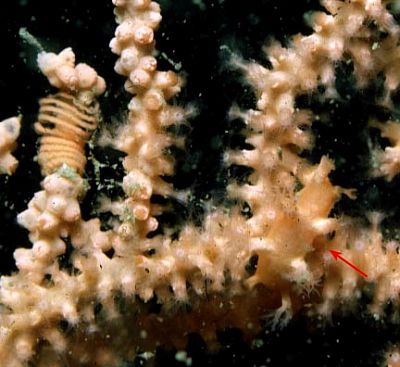
Hi Bill,
I've just seen the recent pictures from Baki Yokes of this species from Turkey, and it does make me wonder what is going on with the diet of this species. In the NE Atlantic the normal colour is salmon pink, but I have seen white individuals, not always matching their sea-fans, Eunicella verrucosa.
Eunicella verrucosa is normally salmon-pink but most populations have a few white ones. On the west coast of Ireland in Galway Bay the entire population of Eunicella is white (presumably reflecting restricted gene-flow at the edge of the species' range). The most northerly populations are in Donegal Bay, the next big inlet to the north, here about 5-10% of the fans are white.
Here are some of my photos to illustrate this variety. I've also sent in a separate message what I think is Tritonia nilsodhneri on a different type of sea fan, perhaps Leptogorgia, off Galicia in NW Spain. Here they were all grey in coloration, on a red sea fan.
UPPER RIGHT: Longue Pierre, Guernsey, Channel Isles - July 1987 - individual and spawn on fan with expanded polyps - showing effectiveness of camouflage
LOWER LEFT: Scilly Isles, SW England - April 2001 - white individual on white fan
LOWER RIGHT: Scilly Isles, SW England - April 2001 - mating pink individuals on pink fan
Bernard
bernard.picton.um@nics.gov.uk
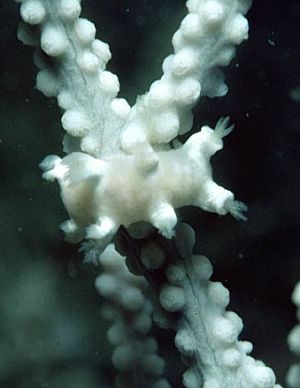
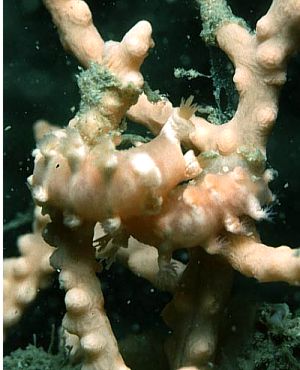
Thanks Bernard,
Bill Rudman
Tritonia nilsodhneri from Spain
October 18, 2001
From: Bernard Picton
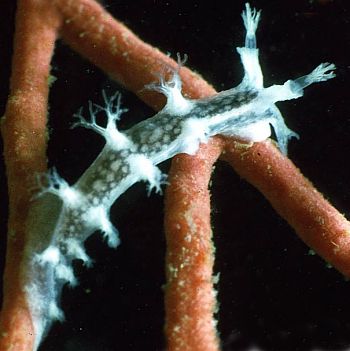
Hi Bill,
To accompany my comments on the colour of Tritonia nilsodhneri in different populations in the NE Atlantic here is a photo of an animal which I think is Tritonia nilsodhneri on a different type of sea fan, perhaps Leptogorgia, off Galicia in NW Spain in July 1978. Here they were all grey in coloration, on a red sea fan.
Bernard
bernard.picton.um@nics.gov.uk
Picton, B.E., 2001 (Oct 18) Tritonia nilsodhneri from Spain. [Message in] Sea Slug Forum. Australian Museum, Sydney. Available from http://www.seaslugforum.net/find/5492Thanks Bernard,
Bill Rudman
Tritonia nilsodhneri from Turkey
October 3, 2001
From: Baki Yokes
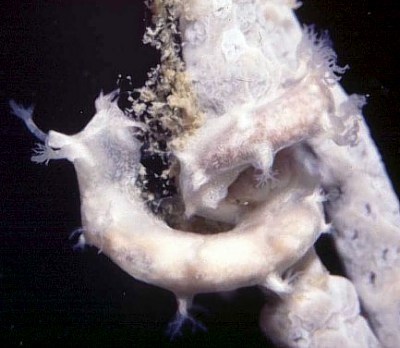
Dear Bill,
I have some photos of Tritonia nilsodhneri taken in Saros Bay, Turkey. Although there are many species of corals, such as Eunicella cavolini, Eunicella singularis and also some Alcyonium species, these animals are always found on E. singularis, the White Gorgonian. Their body colour and shape exactly imitate the gorgonian, which makes them hard to be recognized if they are not looked for. They also leave their eggs on the coenonchyme of the colonies. They always wrap themselves around the branches and become indistinguishable from the colony. What I have observed so far is that, the other gorgonian species were always inhabited by some prosobranchs such as the members of Ovulidae, but the Turkish Tritonia nilsodhneri individuals mostly (if not only) prefer E. singularis, and if I'm not wrong, the photo posted by Erwin is also a E. singularis colony. On the other hand, there are large populations of Eunicella verrucosa in the Sea of Marmara, but I never encountered a T. nilsodhneri on any of those colonies yet.
All photos were taken by me at Canakkale, Turkey. Divesite: Saros Bay. Depth: 20m, June 1998.
Size: Animals - 25mm long; egg ribbon - 5mm diameter
Best wishes
Baki
bakiyokes@turk.net
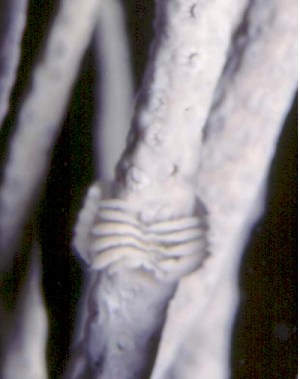
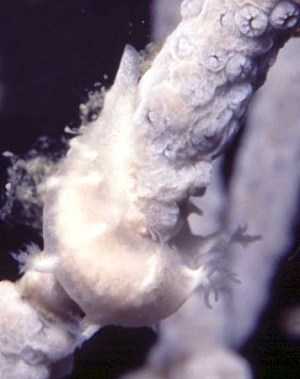
Dear Baki,
Thanks for this interesting information. These cryptic animals are quite fascinating. As you are probably quite aware, it is often the egg masses which alert us to the fact that cryptic nudibranchs are hiding nearby. Best wishes,
Bill Rudman
Food and colour in Tritonia nilsodhneri
May 10, 2001
From: Jane Lilley
Dear Bill
Here I my observations on food, colour and behaviour in Tritonia nilsodhneri to match those I sent earlier on Tritonia hombergi
This species feeds on the sea fan Eunicella verrucosa, which is usually pink, and the Tritonia matches the colour of its host. However, at some sites in south-west Britain, a minority of the Eunicella are white. Tritonia nilsodhneri appears to feed just as readily on the white form as the pink, and again matches the colour of its host. So white fans have white nudibranchs, and pink ones, pink, though the pink fans vary a bit in colour, and the Tritonia is not always a good match - it can be perfect, but it is often too salmony or too beige a shade.
During a series of dives in August last year, when Tritonia nilsodhneri was breeding - mating pairs and egg threads all over the sea fans - several people saw them crawling rapidly across the algae and rocks, often well away from any sea fan. Between us, we saw enough individuals to be fairly sure that they had not been accidentally dislodged, but were deliberately migrating, presumably in search of mates. Specimens of Eunicella with only one Tritonia are common, so for mating to be possible, migration would be needed. At one site, adjacent to a small Eunicella which had a single nudibranch on it, I saw another individual on an algal frond. It was stretching forwards as far as it could, with the front half of its body unsupported as it attempted to reach the sea fan, and was making a determined effort to reach its stem at the point where a small individual of Tritonia nilsodhneri was coiled round it. There seemed no doubt that it knew that the other nudibranch was there, and that it, rather than just the Eunicella, was its goal. Had it perhaps followed a 'scent' in the water to find it?
We also saw several white individuals on pink fans, which I assume had recently moved from one host to another. There were also a significant number of 'pink' Tritonia on pink fans which had unusually dark bodies, although the gills were pink (in Tritonia hombergi, individuals which have recently moved from one colour of Alcyonium digitatum to another appear to change their body colour first, and then the gills). In some cases the whole body was darker, in others it seemed to be just the back. The individuals seen 'migrating' were also often darker-bodied. I wondered whether they were feeding on whatever was available while they were off the Eunicella, and were either making use of a darker pigment from their food, or gradually breaking down their pink pigment and not being able to replace it. If so, the darker-coloured individuals seen on sea fans would have recently migrated, just as the white nudibranchs on pink sea fans must have. I wonder whether individuals which appear to be the wrong shade of pink have also recently moved from one host fan to another of a slightly different colour. If so, such movement must be quite common.
I'd appreciate it if anyone can comment usefully on my speculations, or add further observations.
Jane Lilley
PDL@mm-brig.mottmac.com
Lilley, J., 2001 (May 10) Food and colour in Tritonia nilsodhneri. [Message in] Sea Slug Forum. Australian Museum, Sydney. Available from http://www.seaslugforum.net/find/4312Thanks Jane,
Bill Rudman
Tritonia nilsodhneri from Spain
June 1, 2000
From: Erwin Koehler


Dear Bill,
Here are some Tritonia nilsodhneri from Cala Joncols, nr Rosas, Costa Brava [Mediterranean coast of Spain], both divesite "La Piscina"
UPPER: May 01, 2000, 12 m depth, size 16 mm
LOWER: April 22, 2000, 8 m depth, size of the
slug 13 mm,
The gorgonian prey has been identified as Eunicella singularis. See message from Helmut Zibrowius - 24 Oct 2001.
Erwin.
Medslugs.Koehler@t-online.de
Koehler, E., 2000 (Jun 1) Tritonia nilsodhneri from Spain. [Message in] Sea Slug Forum. Australian Museum, Sydney. Available from http://www.seaslugforum.net/find/2474Thanks Erwin,
Bill.
